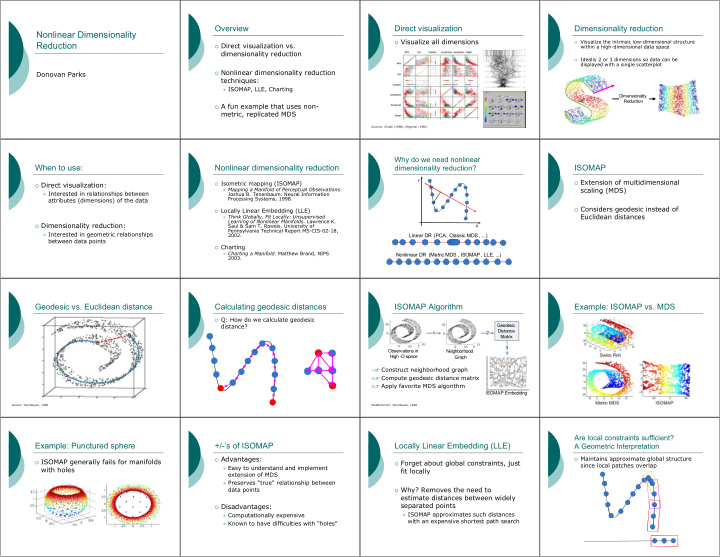



Overview Direct visualization Dimensionality reduction Nonlinear Dimensionality Visualize all dimensions Visualize the intrinsic low-dimensional structure Reduction Direct visualization vs. within a high-dimensional data space dimensionality reduction Ideally 2 or 3 dimensions so data can be displayed with a single scatterplot Nonlinear dimensionality reduction Donovan Parks techniques: ISOMAP, LLE, Charting Dimensionality Reduction A fun example that uses non- metric, replicated MDS Sources: Chuah (1998), Wegman (1990) Why do we need nonlinear When to use: Nonlinear dimensionality reduction ISOMAP dimensionality reduction? Extension of multidimensional Y Isometric mapping (ISOMAP) Direct visualization: scaling (MDS) Mapping a Manifold of Perceptual Observations . Interested in relationships between Joshua B. Tenenbaum. Neural Information Processing Systems, 1998. attributes (dimensions) of the data Considers geodesic instead of Locally Linear Embedding (LLE) Euclidean distances Think Globally, Fit Locally: Unsupervised Learning of Nonlinear Manifolds . Lawrence K. Dimensionality reduction: Saul & Sam T. Roweis. University of X Pennsylvania Technical Report MS-CIS-02-18, Interested in geometric relationships 2002. Linear DR (PCA, Classic MDS, ...) between data points Charting Charting a Manifold . Matthew Brand, NIPS Nonlinear DR (Metric MDS , ISOMAP, LLE, ...) 2003. Geodesic vs. Euclidean distance Calculating geodesic distances ISOMAP Algorithm Example: ISOMAP vs. MDS Q: How do we calculate geodesic Geodesic distance? Distance 1 2 Matrix 3 Observations in Neighborhood High -D space Graph Construct neighborhood graph Compute geodesic distance matrix Apply favorite MDS algorithm ISOMAP Embedding Source: Tenenbaum, 1998 Modified from: Tenenbaum, 1998 Are local constraints sufficient? Example: Punctured sphere +/-’s of ISOMAP Locally Linear Embedding (LLE) A Geometric Interpretation Advantages: Maintains approximate global structure ISOMAP generally fails for manifolds Forget about global constraints, just since local patches overlap Easy to understand and implement with holes fit locally extension of MDS Preserves “true” relationship between data points Why? Removes the need to estimate distances between widely separated points Disadvantages: ISOMAP approximates such distances Computationally expensive with an expensive shortest path search Known to have difficulties with “holes”
Are local constraints sufficient? LLE Algorithm Example: Synthetic manifolds Example: Real face images A Geometric Interpretation Maintains approximate global structure 2 since local patches overlap ( W ) � X � W X � = � i ij j i j 2 ( ) Y Y W Y � = � � � i ij j i j Source: Saul, 2002 Modified from: Saul, 2002 Source: Roweis, 2000 +/-’s of LLE Charting Charting the data Find local coordinate systems Advantages: Use PCA in each chart to determine local Place Gaussian at each point and estimate Similar to LLE in that it considers coordinate system covariance over local neighborhood More accurate in preserving local overlapping “locally linear patches” structure than ISOMAP (called charts in this paper) Less computationally expensive than ISOMAP Based on a statistical framework Brand derives method for determining optimal covariances in instead of geometric arguments Disadvantages: Local the MAP sense Coordinate Systems Less accurate in preserving global Enforces certain constraints to ensure structure than ISOMAP nearby Gaussians (charts) have similar covariance matrices Known to have difficulty on non-convex manifolds (not true of ISOMAP) Conclusion: Connecting the charts Example: Noisy synthetic data +/-’s of Charting +/-’s of dimensionality reduction Advantage: Exploit overlap of each Advantages: neighborhood to determine More robust to noise than LLE or Excellent visualization of relationship how to connect the charts ISOMAP between data points Disadvantage: Limitations: More testing needed to demonstrate Brand suggest a Embedded robustness to noise Computationally expensive Charts weighted least squares Unclear computational complexity Need many observations problem to minimize Final step is quadratic in the number of Do not work on all manifolds error in the projection of charts common points Source: Brand, 2003 Action Synopsis: Aspects of motion Dimensionality reduction Pose selection A fun example Input: pose of person at each frame Action Synopsis: Pose Selection and Illustration . Problem: How can these aspects of motion Problem: how do you select Jackie Assa, Yaron Caspi, Daniel Cohen-Or. ACM be combined? interesting poses from the Transactions on Graphics, 2005. “motion curve”? Typically 5-9 dimensions Solution: non-metric, replicated MDS distance matrix for each aspect of motion Assa et al. argue that best preserves rank order of distances across several distance matrices interesting poses occur at “locally extreme points” Aspects of motion: Joint position Essentially NM-RMDS implicitly weights Joint angle each distance matrix Joint velocity Joint angular velocity Source: Assa, 2005 Source: Assa, 2005 Source: Assa, 2005 Source: Assa, 2005
Finding locally extreme points Example: Monkey bars Example: Potential application Do you need dimensionality reduction? Source: Assa, 2005 Source: Assa, 2005 Source: Assa, 2005 Source: Assa, 2005 Critique of Action Synopsis Literature Papers covered: Pros: Mapping a Manifold of Perceptual Observations . Joshua B. Tenenbaum. Neural Information Processing Systems, 1998. + Results are convincing Think Globally, Fit Locally: Unsupervised Learning of Nonlinear Manifolds . Lawrence Saul & Sam Roweis. University of Pennsylvania + Justified algorithm with user study Technical Report MS-CIS-02-18, 2002. Charting a Manifold . Matthew Brand, NIPS 2003. Action Synopsis: Pose Selection and Illustration . Jackie Assa, Yaron Caspi, Daniel Cohen-Or. ACM Transactions on Graphics, 2005. Cons: Additional reading: - Little justification for selected aspects of Multidimensional scaling . Forrest W. Young. Forrest.psych.unc.edu/teaching/p208a/mds/mds.html motion A Global Geometric Framework for Nonlinear Dimensionality Reduction. Joshua B. Tenenbaum, Vin de Silva, John C. Langford, - Requiring pose information as input is Science, v. 290 no.5500, 2000. restrictive Nonlinear dimensionality reduction by locally linear embedding. Sam Roweis & Lawrence Saul. Science v.290 no.5500, 2000. - Unclear that having RMDS implicitly Further citations: weight aspects of motion is a good idea Information Rich Glyphs for Software Management . M.C. Chuah and S.G. Eick, IEEE CG&A 18:4 1998. Hyperdimensional Data Analysis Using Parallel Coordinates . Edward J. Wegman. Journal of the American Statistical Association, Vol. 85, No. 411. (Sep., 1990), pp. 664-675 .
Recommend
More recommend